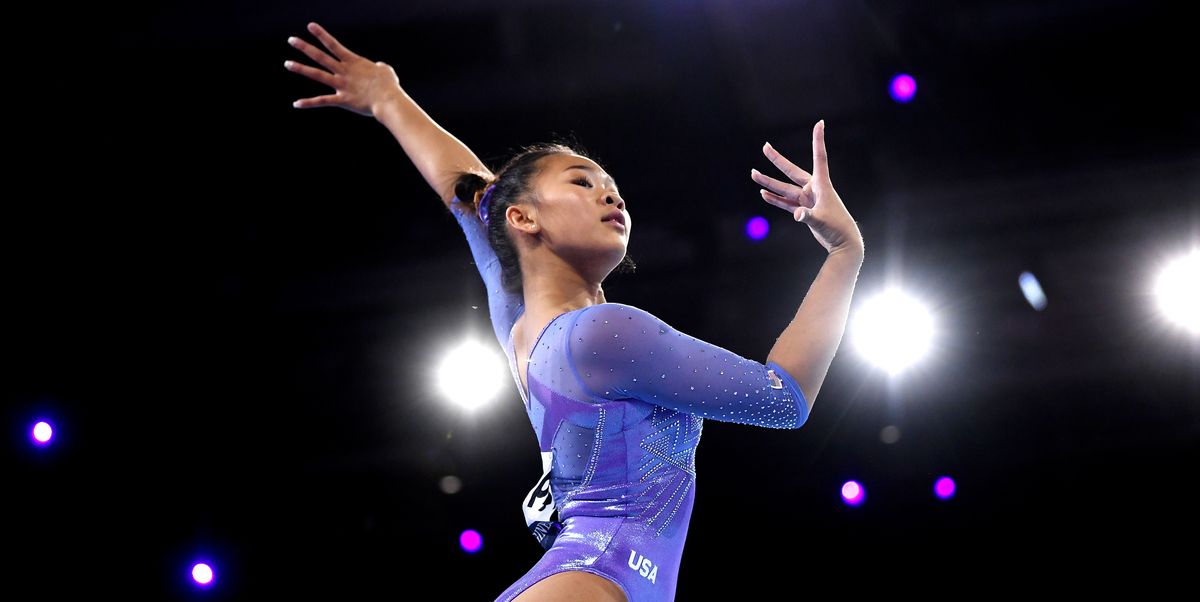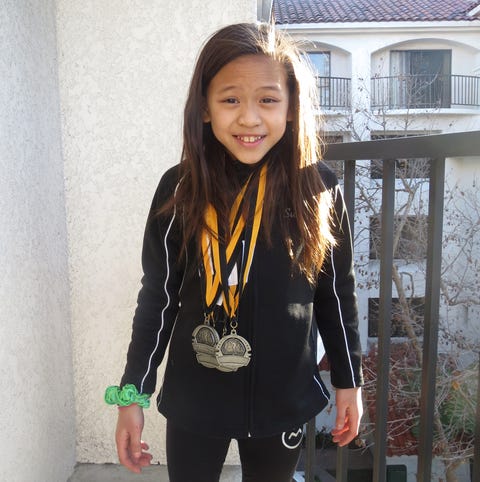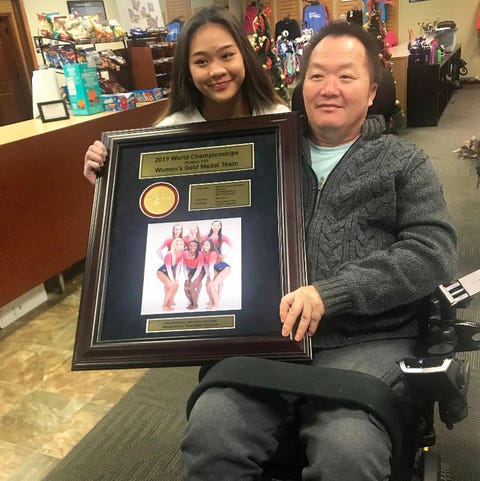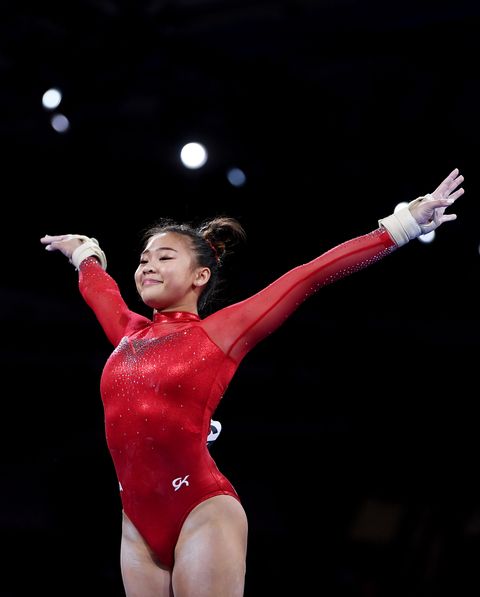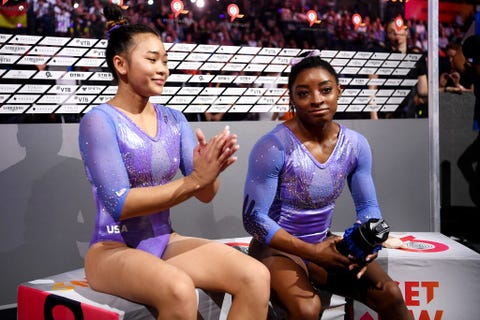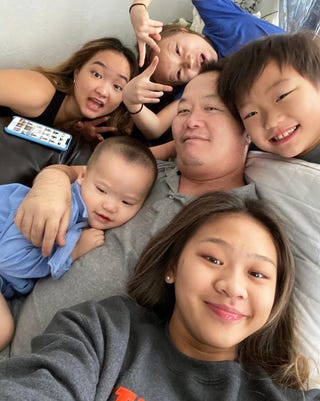Simone Biles, by all accounts the greatest gymnast of all time, was all but guaranteed a gold medal in the individual all-around at the Tokyo Olympics. When she exited to focus on her mental health, the competition suddenly opened up again—and Sunisa Lee rose to meet the challenge. The 18-year-old Team USA star, who already made history this year as the first-ever Hmong American Olympic gymnast, dominated the competition to win gold in the all-around, the fifth straight U.S. woman to place first in the event.
Back in May, ELLE.com profiled Lee on her journey to the Olympics. Read all about the newest all-around champion, below:
It’s a late afternoon in April, and Sunisa “Suni” Lee is where most people find themselves a year into the pandemic: home, in a sweatshirt, talking into a webcam. The 18-year-old gymnast is poised to make history at the summer Olympics, but over Zoom, she’s just like any other teenager, reflecting on everything she’s balancing behind the scenes.
While training for a wildly unpredictable games, Lee has been caring for her recently paralyzed father, mourning the deaths of her aunt and uncle due to COVID, and recovering from a broken foot that jeopardized her lifelong dream to win gold. Now Lee, whose parents emigrated from Laos, is also fighting to qualify as the first-ever Hmong American Olympic gymnast—all while her community contends with a national surge in anti-Asian violence. “People hate on us for no reason,” Lee says from her parents’s house in St. Paul, Minnesota. “It would be cool to show that we are more than what they say. I don’t know how to explain that…”
Lee’s father inches his wheelchair closer into the Zoom screen and answers for her. “It would be the greatest accomplishment of any Hmong person in the U.S. ever,” he says. “It will go down in history.”
Before the Tokyo Olympics were postponed in March 2020, Lee’s family was preparing for the trip of a lifetime. Though she hadn’t actually made the team yet, her parents John Lee and Yeev Thoj had no doubts. They bought plane tickets to watch their daughter compete, and planned to celebrate afterward with a trip to Laos to show Lee and her siblings where they grew up. Both John and Yeev are Hmong, an ethnic group made of people primarily from Southeast Asia and areas in China who fought alongside the U.S. in the Vietnam War. After losing most of their land in the war, many Hmong fled to Thailand as refugees. By the late ‘70s and ‘80s, around 90 percent of the refugee population had resettled in the U.S., where there are now 18 Hmong clans, the largest residing in Minneapolis-St. Paul.
Lee describes her community there as “really close.” More than 300 people come to her family’s annual camping trip, and she can’t go to a local Asian store without someone asking after her dad. She has become something of a local celebrity herself. At Hmong events, Lee gets stopped for photos by people who tell her how proud they are. “It’s nice knowing I have them to fall back on,” she says. “The support is amazing.”
But last May, just two months before the Olympic opening ceremony was originally scheduled to take place, Lee’s family and the rest of the Twin Cities Hmong community found themselves thrust into the national conversation over race and policing. Kellie Chauvin, the now ex-wife of Derek Chauvin, the officer who murdered George Floyd, is Hmong American. So is Tou Thao, another officer on the scene who is set to stand trial in August on charges of aiding and abetting second-degree murder and aiding and abetting second-degree manslaughter in connection to Floyd’s murder. As part of the ensuing protests, several nearby Hmong American businesses were vandalized. John says it got “scary” when several homes on their block were broken into.
“I was trying to make the Hmong community more known,” Lee says. “When that happened, I felt like it was a setback.”
Lee’s journey to the Olympics started with a lumpy mattress and a piece of plywood. Her parents were eager to preoccupy their energetic, gymnastics-obsessed seven-year-old, and a balance beam seemed like the perfect distraction. John built a four-foot-long structure from a spare mattress that, to his credit, still stands in their yard today. He also taught Lee, who’s one of six kids, how to do flips on the bed.
By then, Lee had captured the attention of Jess Graba, a coach at Midwest Gymnastics. “It was super raw and she was just a little kid, but she had some talent,” Graba says, remembering when they met. “Her flips were kind of crazy—she had been practicing in her yard—and she clearly had some ability to go upside down without fear.”
In 2016 when she was 14, Lee was named to the U.S. junior national team, and it became clear Graba could be coaching one of the next great American gymnasts. They traveled around the world together for competitions, and by 2018, Lee had won a gold medal on uneven bars at the National Championships. Five-time Olympic medalist Nastia Liukin, Lee’s longtime hero, took notice of the high-flying athlete. “Her abilities as a gymnast, especially her bar routine, are incredible,” Liukin tells ELLE. “But it’s the unparalleled mental strength that she has shown during the most difficult time of her life that make her the person she is.”
Just two days before the 2019 National Championships, John fell from a ladder while trimming a tree. He was paralyzed from the chest down. At the time, Graba thought Lee shouldn’t compete out of concern for her safety: A distracted athlete is a danger to themselves because they are much more likely to lose focus and get injured. It would have been a devastating end to a decade of training, as nationals are like an unofficial pre-qualifier for the Olympic Games. But John remained confident in his daughter’s ability to compete under pressure. Before Lee stepped onto the mat, they FaceTimed and he advised her to clear her mind—and remember to have fun. “She can stay focused when she puts her mind to it,” he says.
As John watched the competition from his hospital bed, beaming with pride, Lee won the silver in all-around competition, nailing one of the hardest bar routines in the world. One month later, at the U.S. World Championships selection camp, she came within four-tenths of a point of beating Simone Biles in the all-around—the closest anyone has come to Biles in years—and landed one step closer to fulfilling her Olympic dream.
In March 2020, Lee was scrolling through Twitter after practice when she saw the news: The Olympics were postponed, for the first time in modern history, due to COVID. Lee wiped tears away with chalky hands as years of carefully laid plans were thrown into limbo. “To have that taken away from us without having any control is very hard,” she says. “I went through a depressed phase, and it was hard to get out of.”
For weeks Lee could do little more than sleep and cry. Her gym was closed for three months— practically an eternity in the unforgiving timeline of an elite gymnast. When it did reopen in June, Lee broke her foot, meaning three more months of downtime. “If you were 100 percent ready for the 2020 Olympics, then you’re spending the year going, ‘Let’s just not get injured. Let’s just not make any mistakes,’” Graba says.
Lee found an unexpected source of comfort in Biles, who went from being her biggest competition to one of her closest friends after they competed in 2019. “She was there for me,” Lee says. During lockdown, they Snapchatted and texted—two of the only people in the world who truly understood the gut-punch of waiting another year for the Games to begin.
Then, as the country continued to face rising COVID rates in summer 2020, Lee’s own family was devastated by the virus. Her aunt and uncle—close family members who babysat her as a kid—both died of COVID less than two weeks apart. Lee’s uncle, a Hmong shaman, had helped heal her hurt foot with hot ginger and other herbal medicines. Like so many others did during the pandemic, Lee said goodbye over Zoom.
As the nation slowly starts to heal, so has Lee. She can now spot small silver linings from the past year, like spending more time with her siblings and driving her dad to doctor’s appointments, which she calls “good for me mentally, because typically I’m never with them.” It has taken months and months to get back to the peak shape she was in pre-pandemic, but now it’s full steam ahead. The U.S. Championships are the first week of June, and the Olympic trials are later that month. Lee says the extra year has strengthened her performance on the uneven bars and made her more consistent overall. “I just didn’t want to see myself fall back,” she says. “I don’t want to disappoint my coaches or my parents.”
Still, a spot on the team isn’t guaranteed. For the first time in history, U.S. women’s gymnastics has only four open spots (down from five at the 2016 Games), one of which will almost definitely go to Biles. At this point, it might be harder for a U.S. gymnast to make the Olympic team than it is to actually win a medal once they’re there.
Unsurprisingly, none of this seems to phase Lee. She is no stranger to finding the best version of herself under intense circumstances—the version that wins medals, defies gravity, and advocates for her community. Before falling asleep at night, she visualizes herself sticking a perfect landing and coming home as the first Hmong American Olympic gymnastics champion. History made.
Video Edit: Kameron Key | Director of Photography: Kiera Faye | Camera & Gimbal Operator: Josh Voelker
To learn more about all the Olympic hopefuls, visit TeamUSA.org. The Tokyo Olympics begin July 23 on NBC.
